Animal behaviour research highlights close collaboration between students and faculty
Students at Yale-NUS College work closely with faculty members on campus, enabling many of them to participate in collaborative research projects to deepen their learning. Specifically, Haaken Bungum (Class of 2021), Akin Heper (Class of 2022) and Youngbean Kim (Class of 2022) conducted animal behaviour research under the supervision of Senior Lecturer of Science (Life Sciences) Dr Philip Johns, and obtained commendable results. They presented their findings at the 58th Annual Conference of the Animal Behaviour Society (ABS) in August. Haaken also won an Honourable Mention for the ABS Genesis Award for the Outstanding Undergraduate Poster Presentation.
He previously conducted a one-semester Independent Reading and Research (IRR) project on multiple females exhibiting reproductive activity or traits within families of Singapore’s smooth-coated otters, which is an uncommon phenomenon as otter family groups usually have a dominant mating pair. While carrying out further research during the circuit breaker period for his capstone project, he analysed otter-water monitor interactions and estimated what led to violent attacks by otters on water monitors by gleaning data from YouTube and social media sources. Apart from presenting the results at the ABS conference, his research also won the Best Capstone in Life Sciences award this year.
 Haaken’s project is on multiple reproductive females within families of Singapore’s smooth-coated otters. Image Provided by Haaken Bungum.
Haaken’s project is on multiple reproductive females within families of Singapore’s smooth-coated otters. Image Provided by Haaken Bungum.
Despite being a Politics, Philosophy and Economics (PPE) major, Akin did not give up on his interest in the life sciences while at Yale-NUS. He began working with Dr Johns on a Summer Research Project (SRP) in 2019 on stalk-eyed fly behaviour in a previously undescribed species, and the results, which were collected in Thailand, were subsequently analysed in an IRR. His findings suggest that the fly’s eye stalks might have evolved for two reasons – one to project dominance during fighting, and the other as a feature to increase the fly’s attractiveness during mating.
 Akin doing field research in Thailand. Image Provided by Dr Johns.
Akin doing field research in Thailand. Image Provided by Dr Johns.
Also benefiting from closely collaborating with Dr Johns, Youngbean performed a formal statistical analysis on TikTok and YouTube videos pertaining to domestic cats’ reactions to augmented reality (AR) filters on camera phones and to mirrors. Similar to Akin, she collected the data as part of a SRP in 2020 and analysed it in a subsequent IRR, allowing her to further expand on her research findings and continue to receive faculty mentorship. Through her project, Youngbean observed the “Clever Hans” effect—when animals react to unintentional or involuntary cues from their owner or trainer—in the videos she studied, leading her to realise that the cats’ apparent reactions to AR filters are really a reaction to their owners’ touch. She also discovered that cats could potentially be categorised into different personality groups based on their reactions to mirrors, such as snarling, retreating or pawing at the mirror. This is not an oft-discussed observation for this research topic.
 Youngbean presenting her research at the Animal Behavior Society. Image Provided by Youngbean.
Youngbean presenting her research at the Animal Behavior Society. Image Provided by Youngbean.
Reflecting on their research experience, the students shared that they are grateful for the close interactions they had with faculty members throughout the process. “We had such good access to faculty members who were willing to respond to everything and make sure we stayed on track. I am really grateful for that, and I think we all benefitted from the ease of communication available at the College,” Haaken shared.
Youngbean echoed similar sentiments and elaborated on the sense of openness that helped her to develop a strong bond with other researchers while they were working on separate projects. “Through Dr Johns, I was able to get information from the other student researchers; he always tries to loop students into different conversations. There were also guidelines created for the analysis so that other students can easily take over.”
Due to the College’s small faculty-to-student ratio, Dr Johns describes the research community at Yale-NUS College as a special and dynamic one. “In doing these research projects, we are interacting with real human beings, not just academics and scholars. I believe this is genuinely one of the strengths of the College. I have taught at a few other schools, and I do not usually see this level of engagement in many places,” he noted.
Looking ahead, this experience has also helped the students better prepare for what is to come after graduation. “As I start looking for jobs in consulting and finance, I always emphasise this research experience to potential employers. Project management, working independently and collaborating with others in a team are very valuable skills I picked up from the research project,” Akin explained.




